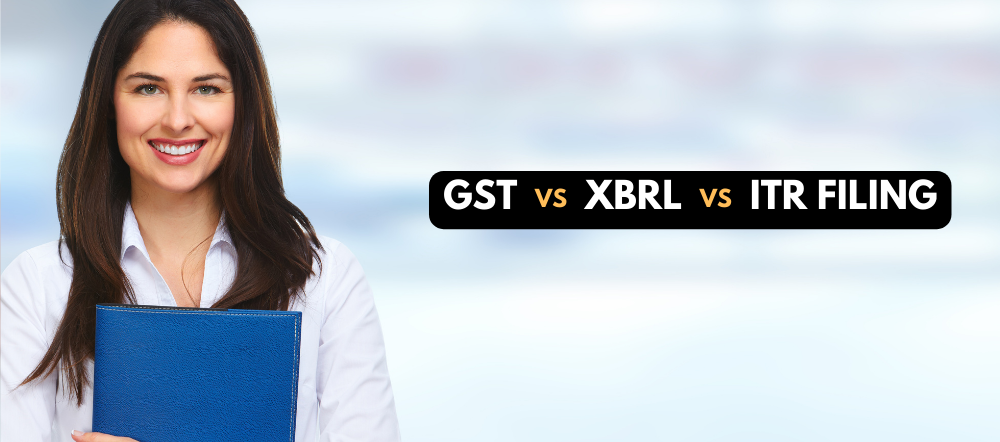Difference between GST, XBRL and ITR Filing

Singaporean companies have to fulfil various statutory requirements to be compliant. XBRL filing is one such requirement. XBRL is a format they must use to file their Financial Statements (FS) with the IRAS.
It is important for business owners to learn about the XBRL filing requirements to be compliant. Read on to learn the difference between GST and XBRL filing.
What is XBRL?
XBRL is an ‘eXtensible Business Reporting Language’. It is an XML-based reporting format used to exchange financial data.
Why do Companies Need XBRL Filing?
Before XBRL, companies used to file their financials in their chosen format. It took a lot of work for the receiver to develop software to accommodate these formats.
- XBRL format helps streamline the data reporting
- It enables the receiver to test and analyse the data
- Companies can then publish their reports in the format most convenient for their stakeholders
- Investors, governments, financial experts, and institutes use this data to identify trends and make decisions
4 Templates for XBRL Filing
As per ACRA, Singaporean companies must file their Financial Statements (FS) in one of the following 4 XBRL formats.
Full XBRL
This template is revised and now contains about 210 data elements. It is used to process financial data in primary statements and selected notes to the FS.
Simplified XBRL
Use the Simplified XBRL template instead of the old XBRL FSH (General). It is updated and now contains about 120 data elements.
XBRL FSH (Banks)
XBRL FSH (Banks) template contains about 80 data elements.
XBRL FSH (Insurance)
XBRL FSH (Insurance) template contains about 80 data elements.
Difference Between GST and XBRL Filing
If you are new to Singapore, you will be better off knowing various terms the locals use.
GST is an acronym for Goods and services tax. It is an indirect tax levied on consumption in Singapore. GST-registered business owners collect 8% of GST from their customers. At the end of their GST cycle, they pay the IRAS through GST filing Singapore.
XBRL filing involves submitting a company’s financial data to regulating agencies. First, they format this data using prescribed XBRL tags and data elements.
In short, the difference between GST and XBRL is that the GST is a consumption tax, and XBRL is a format for filing a company’s financial data, making GST filing and XBRL filing different terms.
When you do the GST filing for your company, you essentially pay the IRAS the total GST amount you collected from your customers over the cycle.
When you do the XBRL filing for your company, you convert and send your complete financial statements to ACRA using XBRL format.
Who Needs to Do XBRL Filing?
Unless exempted, all companies (unlimited or limited by shares) doing business in or registered in Singapore must file their complete FS in XBRL format. XBRL is an electronic format that simplifies financial reporting.
Financial Statements Comprises Must File
- Balance Sheet statement
- Profit and loss statement
- Statement of Cash flow
- Changes in shareholder’s equity
- Notes to accounts
Who is Responsible for XBRL Filing?
As per the ACRA’s mandate, directors are responsible for their company’s XBRL filing. It is why companies hire professional services for XBRL filing Singapore. They execute the task following SFRS and SFRS for Small Entities.
Singapore Businesses Exempted from XBRL Filing
- Partnership
- Limited partnership
- Sole proprietorship
- Dormant companies, under Section 201A of the Singapore Companies Act
Organizations Not Supervised by ACRA
Here is a list of organisations that report to an agency other than ACRA:
- Banks (Merchant and Commercial)
- Singapore registered insurers
- Financial companies
Singapore Monetary Authority supervises banks, insurance and reinsurance companies. Hence, they have to abide by its specific requirements.
Due Dates for XBRL Filing
A Singapore company has to file its annual returns in XBRL format within seven months from the end of its financial year.
So to reiterate, the difference between GST and XBRL is that GST is a tax on the supply and consumption of goods and services in Singapore, and XBRL is a format for reporting data.
ITR Filing
Singapore companies need to pay corporate income tax on their chargeable income. It is charged at a flat rate of 17%. Depending on their circumstances, they must fill and file Form C-S/ Form C-S (Lite)/ Form C for their ITR filing.
Companies, through ITR filing, provide information about their taxable income and the tax amount due from them. For the Year of Assessment (YA) 2023, the due date for ITR filing for your company is 30 Nov.
Which Form to Fill – Form C-S/ Form C-S (Lite)/ Form C?
Form C-S
Companies incorporated in Singapore need to use Form C-S to file their ITRs. They also need the following:
- $5 million or less in annual revenue
- Income that is taxable at 17%; and
- Are not claiming:
- Carry-back of current-year capital allowances or losses
- Group relief
- Investment allowance
- Foreign Tax Credit and Tax Deducted at Source
Form C-S (Lite)
Companies that qualify to file Form C-S and have $200,000 or less in annual revenue can file Form C-S (Lite).
Form C
Companies that cannot file Form C-S/ C-S (Lite) must file Form C. They must file their FS, tax computations and supporting schedules with Form C.
Difference between Corporate Income Tax and GST
Taxpayers GST in Singapore is an indirect tax. Corporate income tax is a direct tax. In 1994, Singapore income tax rate was 40%.
So, GST is a tax on the supply and consumption of goods, and supply was introduced to lessen the pressure on direct taxpayers. Currently, the GST rate is 8%.
In short, ITR filing tells IRAS your company’s taxable income and the tax amount you must pay.
So, it is all about the difference between GST and XBRL and ITR filing. SBS Consulting Pte Ltd is an experienced provider of corporate services. Call us at +65-6536 0036 or email us at info@sbsgroup.com.sg to learn about our customised solutions.





